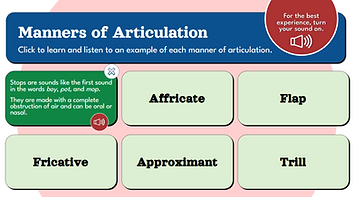
Interactive Phonetics eLearning Modules
Click on the video below to see a preview ⬇

These responsive eLearning modules allow phonetics students to review and practice what they have learned, focusing on consonants and vowels.
-
Audience: Phonetics students
-
Responsibilities: Instructional Design, eLearning Development, Visual Design
-
Tools Used: Articulate Storyline 360, Adobe Illustrator, Procreate, Figma, Audacity, Google Suite
The links below will open in a new tab.
Try it out now or continue on to learn more⬇
The Problem and the Solution
Phonetics students often struggle with understanding and retaining speech sounds due to the overwhelming amount of information in traditional courses. Complex topics like place and manner of articulation, along with consonant and vowel characteristics, can be difficult to grasp without enough opportunities for practice and review. Many students need more interactive exercises to reinforce their learning and avoid feeling overwhelmed.
To address this challenge, I designed a series of interactive eLearning modules focusing on consonants and vowels, with a specific emphasis on place and manner of articulation. The modules use a combination of visual aids, interactive reviews, and retrieval practice to break down complex content.
Key features include drag-and-drop exercises for articulation practice, card-flipping activities with audio examples for manners of articulation, and opportunities for learners to engage physically by producing sounds themselves to better understand their production. This approach aims to simplify the material and provide ample practice, helping students build confidence in identifying, distinguishing, and physically producing speech sounds.
Results
While formal impact measurement is still pending, initial feedback has been positive, particularly regarding the places of articulation module. Students have expressed that the interactive elements, such as dragging and dropping articulation points and practicing the sounds themselves, significantly enhanced their understanding and engagement.
Moving forward, I would seek feedback from students through interviews or surveys to gauge the effectiveness of these modules in improving their knowledge and skills. Additionally, I would track students' test scores to assess any improvements in their ability to identify and produce speech sounds. Early informal feedback suggests that these modules are helping students feel more confident in their phonetic knowledge and practice.

